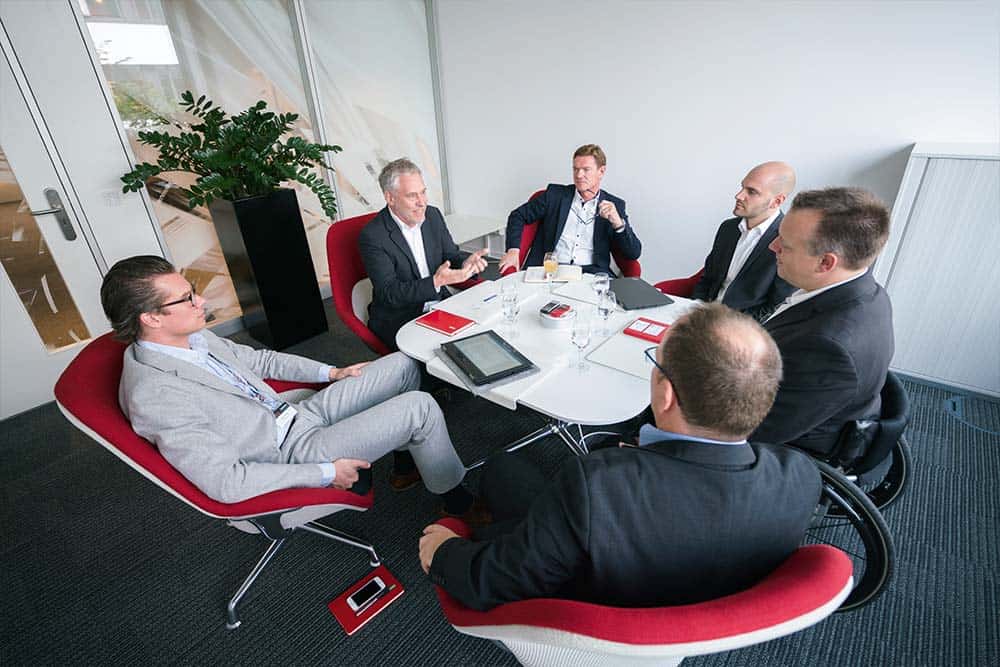Hyperconverged Infrastructure


For years, there was successful consolidation, harmonization, virtualization and automation. But ultimately, the old IT concepts have had their day. What the existing SAP customer needs is an agile, scalable, highly automated IT-Infrastructurein which it retains air sovereignty: A hyperconverged infrastructure from Lenovo and Nutanix is the answer.
For a location determination in the digital transformation and in search of the best possible IT-Infrastructure Roland Goll, Jannes Driesch (both Lenovo), Alexander Thoma, Bas Raayman (both Nutanix) and Carlo Velten from Crisp Research met in Stuttgart at the end of August.
Representatives from Lenovo and Nutanix joined the analyst to discuss the status and options of an existing SAP customer seeking to master digital transformation while maintaining the ITBudget must consolidate.
The consensus was that it was necessary to respond quickly and efficiently to new markets and business requirements, but that this agility was unlikely to be achieved with legacy IT tools and a traditional on-premise client/server environment.Server-architecture will have to be mastered.
Likewise, a general Cloud computing not solve the challenges.
Roland Goll, Manager Solution Sales SAP Sales Central at Lenovo, quickly put it in a nutshell:
"In any case, the existing SAP customer must retain air sovereignty."
Analyst Carlo Velten, CEO at Crisp Research, also emphasizes this strategy, which is obviously vital for SAP's existing customers:
"You always have to retain a degree of independence in all transformations - with your own SAP-License and also about the Infrastructure."
It is therefore important to maintain sovereignty not only over the IT-Infrastructurebut also about the Data to preserve: Where are the Data stored and who can process them.
Carlo Velten strongly emphasizes the value of the Data and their Availability. For SAP applications in particular, data management and controlled IT infrastructure more important than general mobile and cloud solutions.
In this context, during the Lenovo/Nutanix call, the analyst points to the path taken by Amazon, Google and other web giants:
These companies have their own Hardware–Infrastructure completely automated with software. They have built their own hyperconverged infrastructure.
"Hyperconverged is the path to completely automated IT infrastructure"
defines Carlo Velten.
Obviously, neither the digital transformation nor the necessary agility and scaling will be achieved with the old IT structures. But even the cloud can only be a solution to a limited extent if the existing SAP customer follows the SAP roadmap but, as Roland Goll from Lenovo emphasizes in conversation, should retain air sovereignty.
A hyperconverged infrastructure that not only supports its own Data at Data center but can also connect productively with cloud services seems to be the logical answer here.
Flexible, agile and bimodal planning work
For the person responsible for SAP CIO it is becoming increasingly difficult to make validated forecasts about the IT-Infrastructure and thus also to create sustainable budget plans.
Bimodal and agile IT as well as business processes that have to comply with the digital transformation make the planning work difficult.
Today, more than ever, flexibility and scalability are required. Alexander Thoma, Senior Solutions and Performance Engineer at Nutanix, is convinced that the classic IT infrastructure-lifecycle based on the three-tier SAP client/server model has become obsolete.
Alexander Thoma, senior solutions and performance engineer at Nutanix:
"People kept trying to make IT forecasts for three to five years, which worked in very few cases"
"Only a hyperconverged infrastructure brings the necessary flexibility to the Data center and enables adequate modernization during ongoing operations."
His colleague Bas Raayman of Nutanix adds:
"I stay current with a hyperconverged infrastructure. You can always add new Technology bring in economically."
This also has an impact on the Budgetas Thoma and Raayman jointly emphasize. Because you can bring in new components at any time, you pay as a User ultimately only when you really need the new resources.
Jannes Driesch, HyperConverged Sales Account Manager at Lenovo, therefore also sees a rethink with regard to IT budget planning.
Scalability decides
Based on the specific history of the SAP community, the path to the cloud seems feasible, but a much more logical approach is obviously a hyperconverged infrastructure that supports the company's own Data center or the Managed Services can connect to optional cloud services.
For Roland Goll, the advantage of this hybrid, bimodal technology lies in the Scalability, or as he explained it:
"With Lenovo and Nutanix-.Technology the SAP inventory customer can build breathing systems."
This flexibility for upsizing and downsizing seems particularly appealing and also necessary due to the dynamic markets.
The panel agreed that in any case, the existing SAP customer should retain its personal air sovereignty for licenses and infrastructure.
Jannes Driesch from Lenovo thus emphasizes:
"Getting started with hyperconverged infrastructure is also easy and highly recommended because scaling is very easy, flexibility is very high."
You start small, maybe not with the production system right away, and continue to breathe, grow, scale.
The IT paradigm
Roland Goll raised the question of whether the Lenovo/Nutanix hyperconverged infrastructure represents an evolution, a new paradigm or a revolution.
Goll confirmed the insight made at the beginning that the SAP community has done its homework: They have consolidated, harmonized, automated and virtualized.
Roland Goll:
"But for that homework, in the past, you've got Storage, network and Server considered individually. The current added value is that CPU, memory, and Storage now form a single entity and you only have to manage this central, consolidated entity."
And this opens up new opportunities for all SAPUser the great opportunity for a next qualitative step after consolidation, harmonization and automation.
Hyperconverged Infrastructure can preserve the experience and lessons learned from the past and add scalability and agility.
New claims
Bas Raayman of Nutanix explains why:
"The services, how we consume IT power, have changed a lot.
An example here can be Hana. I consume the DataI prepare them at the moment when I really need them.
At the Hasso Plattner Institute in Potsdam, it was impressively demonstrated that any information can be used again as a starting point for new calculations, and that in Real-time.
This has changed the entire database architecture. The demand to be able to react immediately and to get information is omnipresent - thus, at the base, the Technology Change."
For end users, perhaps less will change, as consumers are used to real-time communications on their personal smartphones.
Accordingly, the challenges lie in the Business processes. Here we need a new IT architecture for the SAP roadmap, which does not equate to an unopposed path to the cloud.
Why change?
Alexander Thoma sees the necessary changes, in the Lenovo/Nutanix conversation he thus asks the rhetorical question: Why did these changes occur?
Why have existing SAP customers started to virtualize?
"It's about improving the Availability", is his answer to the round. Digital transformation also means a 24×7Availability in the global markets. This agile, dynamic and flexible 24×7 concept comes at the price of a significant increase in IT complexity.
A traditional SAP client/Server-Keeping an R/3 architecture online around the clock, 365 days a year, is no trivial task. The classic R/3Infrastructure from Server, storage and network was not prepared for such requirements.
The "new" complexity is something many are struggling with, confirms both Lenovo and Nutanix.
Thoma:
"That's why the hyperconverged infrastructure evolved. With it, we reduce the complexity on the surface for the CIO massive and with less complexity there are fewer Risk. Little Risk is always good."
Nutanix also sees its solution offered with Lenovo as an invisible enterprise cloud platform.
The logical step
Looking at the past successful years of the SAP community, the further development towards hyperconverged infrastructure seems to be the logical next step.
Many existing SAP customers have always relied on their own data center or managed services for technical, organizational and business reasons. A great deal of knowledge and experience has been gained here, which now needs to be put to good use. That sounds like evolution.
But the analyst warns.
Carlo Velten, Crisp Research:
"Against the backdrop of digitalization, we are seeing a reorientation of management at companies. Even the market leaders here in Germany recognize that you have to become faster and more agile.
And then you have to realize that your own Business processes, the own Infrastructure and even IT can't keep up with this change."
Complex past
The current SAP state is based on the paradigms of ten to fifteen years ago. The ERP/ECC 6.0 architecture is complex and multi-layered and with many Technologies of different providers. This makes the current architecture technically and organizationally complex.
"This complexity is in contrast to the current challenges, such as new, agile Business processes, new digital processes, new products are to be introduced".
Velten explains.
"What we've learned to date is that it's not done with a few workshops on design thinking.
Because when it really gets serious about digital transformation, you need Data from the large back-end systems - i.e. Data from the SAP systems."
Datability & Big Data
Datability was rightly a big theme at CeBIT, and Big Data still is.
Then comes the point where the person responsible for SAP, with regard to his or her Infrastructure should account for, and Carlo Velten asks the question:
"Is this base designed to meet current requirements?"
The analyst answers for all the same himself:
"In many cases, the SAP-Infrastructure not be able to be correspondingly agile, fast and in Real-time to react. And when I see it as CIO maybe can't do it myself or know how to do it, then maybe I outsource the SAP operation."
With Managed Services or Cloud computing must be the CIO then no longer ask many questions regarding agility. But what is important are the requirements imposed by the business side and the question of whether my current ERP–Infrastructure can meet these requirements, the analyst points out.
Carlo Velten explains it this way: "Many managing directors think they don't need to be interested in IT.
"We need to work with our Business processes act quickly and IT comes after"
is an often-heard answer.
The pressure on infrastructure managers is immensely high because these current SAP systems represent an enormous cost block, Velten knows from his research.
Orientation in infrastructure and licenses
For Roland Goll of Lenovo, the trick is to know where and when to start the transformation. So where do you start with a hyperconverged infrastructure?
Bas Raayman of Nutanix confirms:
"One clearly observes that SAP's existing customers are looking for orientation - in terms of Infrastructure, Licenses etc.
Not to maybe change anything right away, but what do I need in two years, what challenges will there be then? Of course, you then fall back on proven providers like Lenovo.
But what is the future strategy of the Customers off?
So we are already working on what will be current in two years and what the User then wants to do. But it's difficult to really assess what will happen in two years' time.
The hyperconverged approach is a new learning offering to the Customers."
SAP Roadmap
However, Carlo Velten points out: "The challenge is not only to find your own path for the next two or ten years, but also to take into account what SAP is planning.
"So you have to deal with two dimensions".
Velten explains.
"SAP is making a clear statement here: Cloud is the strategy. Cloud means scalable, flexible, fast deployment.
The SAP manager must therefore ask himself: What does my management want? What does SAP want?"
Hyperconverged Infrastructure and Cloud computing are therefore two concepts for coping with the future requirements of a digital transformation.
Interesting: Hyperconverged Infrastructure with Lenovo and Nutanix delivers the same expectation that an SAP sets with its cloud strategy - but in its own Data center.
AP goes to the cloud
The analyst sees the future ahead:
"SAP is moving in the direction of the cloud. So in two years at the latest, IT managers will have to prove that they can work with their own IT architecture provides the same performance and agility as SAP with its cloud model. The CIO Is competing with SAP Cloud."
Accordingly, Carlo Velten's summary is that the CIO In the future, a hyperconverged infrastructure should provide SAP services as if they were coming from the SAP Cloud.
Alexander Thoma and Bas Raayman confirm together: The bottom line is that you are looking for certain qualities.
I'm less interested in where it runs - at SAP, at Amazon, in a mixed operation. "My application has to run," Raayman demands.
Invisible Infrastructure is also what the experts at Nutanix call it.
"Which is not to say that I don't have Hardware have"
Thoma adds.
"I need a Hardwarethat enables the new concepts, which is definitely the case with Lenovo. The structure must have certain characteristics - as flexible, secure and agile as possible.
I choose a platform that delivers these features, this is where collaborations like Lenovo and Nutanix are a key concept."
Cost pressure & workloads
The SAP responsible CIO must therefore think about what I can do as a CIO to the outside world, says Roland Goll of Lenovo.
There is just considerable cost pressure with regard to the various cloud models.
But what is true for the SAP world?
Bas Raayman of Nutanix:
"Of course, you have to have confidence in cloud technology."
Bimodal also means positioning innovative solutions on the outside, but acting relatively conservatively on the inside. A combination of cloud and hyperconverged infrastructure seems appropriate.
"But start now," Raayman cautions in the Lenovo/Nutanix conversation. Alexander Thoma specifies once again:
"Workloads are moving to the cloud because of rapid deployment. The Nutanix Enterprise Cloud Platform reduces complexity and also brings rapid deployment."
The Nutanix alternative: all the benefits of the cloud, but in the controlled environment of your own data center or Managed Services.
Thoma defines that Nutanix's enterprise cloud platform with flexibility can always be a mix of on-premise and on-demand, which is why the platform idea is so important.
Roland Goll also sees a current focus on IT agility and that IT costs do not continue to rise.
"But where is my core competency?"
he asks the group. Does it lie in the IT-Infrastructure? Goll's answer:
"Freeing up resources to improve the SAP system!"
Carlo Velten also recommends reducing complexity at the grassroots level through automation, because much of the complexity is tied up in the Infrastructure.
"We're still swimming in money at the moment," the analyst says with a wink, but the Infrastructure–Budgets burden the CIO.
"Prepare for economic downturn," is therefore the recommendation of the Crisp Research analyst.
Plan the future anew
The SAP responsible CIO must prepare for a wave of cost savings. The pressure on SAP systems will increase.
Complementing this, Bas Raayman opines:
"The complexity may not decrease, but you have to reorganize and administer it in the future.
Necessary planning and logic will not disappear, but it shall be made invisible."
Alexander Thoma of Nutanix sees the opportunity for new resource planning through the hyperconverged infrastructure paradigm.
For this there are for the CIO with Lenovo and Nutanix, we have a unique partner, emphasizes Jannes Driesch. For the combination of hyperconverged infrastructure and Cloud computing having only one contact person is a validated reduction of complexity.
Roland Goll:
"Infrastructure has to work, that's the job of Nutanix and Lenovo. As a result, we make complexity invisible."
And Nutanix colleague Alexander Thoma adds at this point:
"We're making it easier for people to own a Data center to operate without cost disadvantages compared to outsourcers and cloud technology."




